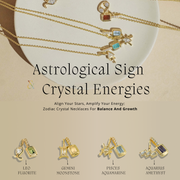Citrine History and Symbolism
Ancient Times
Citrine's history dates back to ancient civilizations, when it was prized for its warm, sun-like glow.
As early as 300–150 BC, the ancient Greeks used it as a decorative gem in jewelry, admiring its beauty and purported protective powers.
In ancient Rome, citrine was often carved into intaglios and used in rings and ornaments. Many believed this golden gem warded off evil thoughts, venomous snakes, and bad luck.
Middle Ages
During the Middle Ages, citrine was highly prized in Europe, not only as a decorative gem but also as amulet.
It was believed to embody the energy of the sun, bringing vitality, clarity, and warmth to its wearer. Healers used citrine to ward off plague, treat digestive problems, and prevent snake bites.
It was also considered a stone of wisdom, believed to strengthen the mind and promote clear thinking.
17th–19th Centuries
In the 17th century, citrine became popular among Scottish weapon makers, who used it to adorn the handles of daggers, both for decoration and as a symbol of strength.
During the Art Deco period of the 18th and 19th centuries, citrine became a popular gem in Europe and the United States.
Hollywood stars wore bold jewelry designs featuring large, richly colored citrine, further enhancing its allure and status.
Modern Times
Today, citrine is revered as the birthstone for November, symbolizing abundance, creativity, and joy.
It is often called the "merchant's stone" because of its association with business prosperity and success, and some place it on cash registers or in the workplace to attract wealth and prosperity.
Due to its durability, vibrant color, and widespread availability, citrine remains a popular choice for jewelry, offering both convenience and profound meaning.
Symbolism
Citrine symbolizes warmth, optimism, and clarity, often associated with the life-giving energy of the sun.
In metaphysical traditions, it is believed to bring prosperity, stimulate creativity, and dispel negativity.
Citrine is also associated with emotional balance, helping to calm anger, enhance self-confidence, and achieve personal goals.
For many, Citrine is a daily reminder of the power of happiness, abundance, and positive thoughts.
Where are Citrine found?

Citrine is mined worldwide, with Brazil being the largest producer. Brazil is renowned for its abundant deposits, often producing amethyst and smoky quartz that have been heat-treated to achieve the golden hue most associated with citrine.
Brazilian citrine dominates the global market due to its quantity and quality, with colors ranging from pale yellow to deep amber.
Elsewhere in the world, notable sources include Bolivia, which produces the rare ametrine.
Madagascar also produces vibrantly colored natural citrine, while Zambia and Namibia produce smaller but high-quality outputs.
Spain, Russia, and France have all historically produced citrine, though production is more limited today.
In the United States, citrine has been found in states such as Colorado, North Carolina, and California, but production is generally smaller than in South American sources.
Many citrine found in the United States is prized by collectors for its natural, untreated hues, rather than for large-scale commercial jewelry production.
What color is Citrine?

Citrine is known for its warm golden hue, ranging from pale yellow to deep amber. This color, derived from trace amounts of iron in the quartz, varies in saturation from a soft lemon to a rich orange-brown.
The most prized citrine typically exhibits a vibrant golden to reddish-orange hue and is sometimes called "Madeira" citrine because of its resemblance to the body of Madeira wine.
Natural citrine is relatively rare; most available today is heat-treated with amethyst or smoky quartz, which enhances its yellow to orange color spectrum.
Despite its diverse varieties, citrine's sunny hue has long been associated with warmth, energy, and positivity, making it a popular choice for jewelry.
Types of Citrine
Natural Citrine

Natural Citrine is a rare variety of quartz whose golden hue comes from trace amounts of iron during its formation.
Its color ranges from pale yellow to warm gold, typically with a soft, even hue.
It is highly prized among collectors because of its natural formation, and its color is often more subtle than that of heat-treated varieties.
Heat-treated Citrine

Most citrine available on the market is actually amethyst or smoky quartz that has been heat-treated to achieve vibrant yellow, orange, or red hues.
This process enhances the saturation of citrine, creating hues richer than those found naturally, including deep gold or burnt orange.
Heat-treated citrine is plentiful and affordable, making it popular in jewelry.
Madeira Citrine

Madeira Citrine is known for its rich reddish-orange to brownish-orange color, named after the fortified Madeira wine.
Its deep, warm hue gives it a luxurious appearance, and it is often considered one of the most striking varieties of citrine.
This color is usually achieved through heat treatment, but it can also occur naturally in rare cases.
Lemon Quartz

Lemon quartz is a bright, clear yellow quartz that belongs to the broader category of citrine.
Its vibrant, almost neon yellow hue is often achieved through gentle heating or irradiation.
Its vibrant, vibrant color makes it a unique and modern jewelry choice.
Ametrine

Ametrine is a naturally occurring quartz that combines the gold of citrine with the purple of amethyst in a single crystal.
This two-toned effect is caused by the varying oxidation states of the iron within the quartz, resulting in a striking and unique gemstone that is often cut to enhance the contrast between the two colors.
Topaz History and Symbolism
Ancient Times
Topaz has been cherished since ancient times, with the earliest records dating back to ancient Egypt.
The ancient Egyptians associated topaz with the sun god Ra. They believed that the golden light emanating from topaz embodied the power of the sun, granting the wearer strength and protection.
The Greeks also revered topaz, believing it to enhance strength and provide invisibility in times of danger.
The Romans associated topaz with their god of the sky and thunder, Jupiter, reflecting its sacred protective properties.
Middle Ages
During the Middle Ages, topaz was widely regarded as a gemstone with healing and protective properties.
It was believed to ward off evil, cure illness, and even soothe the spirits.
Golden topaz was particularly sought after, considered a talisman against toxins and harmful forces.
Clergy and royalty often wore topaz jewelry, relying on its mystical allure for protection.
Modern Times
In recent centuries, topaz has become a symbol of love, affection, and fidelity.
From golden yellow to vivid blue, topaz's rich palette of colors further enhances its appeal.
In the 20th century, blue topaz's popularity soared due to new treatment techniques.
Today, it's not only celebrated as November's birthstone, but is also treasured for its brilliant brilliance and versatility in fine jewelry, symbolizing joy, abundance, and good fortune.
Symbolism
Topaz carries a rich tapestry of symbolism across cultures and time.
Regarded as a gemstone of clarity, communication, and truth, it is believed to enhance interpersonal relationships and stimulate creativity.
Its association with warmth and sunlight makes it a symbol of vitality and confidence, while its calming energy is believed to soothe emotions and promote inner peace.
Whether worn as a protective amulet or as a precious birthstone, topaz symbolizes a balance between strength and tranquility.
Where are Topaz found?

Topaz is found throughout the world.
Brazil is the most famous and prolific source of topaz, particularly Imperial topaz. This rare variety is prized for its vibrant golden-orange to red hues. Brazil also possesses extensive deposits of colorless and blue topaz, making it a major supplier to the global market.
In Russia, the Ural Mountains have historically been renowned for producing striking topaz crystals, often in shades of yellow, pink, and even rich sherry.
Pakistan and Afghanistan are also important sources of topaz, particularly in the Gilgit-Baltistan region, where topaz crystals of exceptional clarity range from pale pink to golden.
Nigeria has become a significant source of topaz, producing a wide variety of colors, including yellow, blue, and pink, often in very large crystal sizes.
Topaz production in Sri Lanka is smaller, typically occurring as water-polished pebbles within gem gravels.
In the United States, topaz deposits are found in Utah, Texas, and Colorado, where it is commonly found in rhyolite caves and granite pegmatites. Utah has designated it as its state gemstone.
Australia also produces high-quality topaz crystals, particularly in New South Wales and Queensland, but production is slightly lower than that of Brazil.
What color is Topaz?

Topaz, with its rich array of colors, is one of the most versatile gemstones.
The most common variety is colorless, often treated to produce a variety of popular blue hues, from a light sky blue to a deep London blue.
Natural topaz colors include yellow, orange, pink, red, brown, and green, each influenced by trace elements and structural variations within the crystal.
Imperial topaz, one of the rarest and most valuable varieties, is known for its vibrant golden to reddish-orange hues, sometimes with pink undertones. This variety is prized for its rich color and natural warmth.
Topaz can also exhibit softer, lighter shades, such as soft peach or pale pink, which are prized for their romantic allure.
Types of Topaz
Imperial Topaz

Imperial Topaz is the most prized gemstone, renowned for its fiery golden, reddish-orange, and pink hues.
Primarily mined in Brazil, this gemstone has long been associated with royalty and luxury.
Its rarity and brilliant sparkle make it one of the most sought-after gemstones, often used in high-end jewelry to symbolize power, abundance, and vitality.
Blue Topaz

Blue topaz is one of the most popular gemstones on the market, although most blue gems are created by heat-treating and irradiating colorless topaz.
Tones range from light sky blue to medium Swiss blue to deep London blue, each with its own unique character.
Its cool tones make it a favorite in modern jewelry design, symbolizing calmness, clarity, and communication.
Colorless Topaz

Colorless topaz, also known as white topaz, is the purest form of the mineral, devoid of any color-causing elements.
While naturally abundant, it is often used as an affordable alternative to diamond due to its clarity and brilliance.
ue to its abundant supply, this type of topaz is often treated to produce other colors, particularly blue.
Pink and Red Topaz

Pink and red topaz are extremely rare and valuable, deriving their color from trace elements such as chromium.
These gems are primarily mined in Brazil, Russia, and Pakistan.
Their delicate, vibrant hues are prized for their romantic symbolism, often representing love, passion, and emotional energy.
Golden and Yellow Topaz

Golden and yellow topaz are among the oldest gemstones in jewelry history and have been prized since ancient times.
They radiate a warm, sun-kissed glow and are often mistaken for citrine, but they are actually more brilliant and harder.
Historically, they were believed to have protective powers and are still cherished for their joyful and uplifting energy.
Green Topaz

Green topaz is less common and ranges in color from light mint to deep forest green.
Some green topaz occurs naturally, but many are created through treatment.
Its soft hues symbolize renewal, harmony, and growth, making it a favorite among collectors who value rare gemstone colors.
Mystic Topaz

A modern masterpiece, Mystic Topaz is a rainbow-like iridescence achieved by applying a thin layer of titanium to colorless topaz.
This treatment imparts a futuristic, multicolored appearance that shifts with light.
Although not a natural gemstone, its unique beauty and affordable price point have made it a popular choice for those seeking unconventional gemstone styles.







